Since the inception of casinos, people have been striving to overcome the challenge of consistently beating the house. Betting systems have been an integral part of the gambling landscape for centuries, flourishing across various civilizations. These systems offer a structured approach to wagering, aiming to turn a profit by applying your bankroll systematically or strategically.
What is Positive and Negative Progressive Betting Systems
Betting systems are structured approaches to wagering that can significantly influence your gambling outcomes. These systems are typically categorized into two types: positive and negative betting systems. Each type has its unique principles and strategies, tailored to manage your bankroll and betting patterns based on previous outcomes.

Crash Gambling Strategies
Positive Betting Systems
In a positive betting system, you increase your bets following a win and reduce them after a loss. The underlying principle is to capitalize on winning streaks and maximize your profits when luck is on your side. By incrementally increasing your wagers during a winning streak, you aim to amplify your gains while limiting your losses when the streak ends. A classic example of a positive betting system is the Paroli system. In this method, you double your bet after each win. For instance, if you start with a $10 bet and win, your next bet would be $20, then $40, and so on, until you either decide to reset or encounter a loss. The Paroli system is designed to take advantage of short-term winning streaks while minimizing risk, as you only bet with your winnings.
Negative Betting Systems
Conversely, a negative betting system involves increasing your bets after a loss and reducing them following a win. The rationale behind this approach is to recover losses by making progressively larger bets, hoping to secure a win that covers all previous losses and provides a profit. This type of system can be riskier, as it requires a substantial bankroll to sustain the increased bets during losing streaks. A well-known example of a negative betting system is the Martingale system. In this strategy, you double your bet after each loss. For instance, if you start with a $10 bet and lose, your next bet would be $20, then $40, and so forth until you win. When a win occurs, you recoup all previous losses plus a profit equivalent to your initial bet. While the Martingale system can be effective in theory, it carries the risk of significant losses if you encounter a prolonged losing streak.
Brief Overview of the Main Betting Systems
| Betting System | Type | Description | Pros | Cons |
|---|---|---|---|---|
| Martingale | Negative | Double bet after each loss; aim to recover losses and gain profit. | Simple to understand and implement. | Requires substantial bankroll; potential for significant losses. |
| Paroli | Positive | Double bet after each win; maximize profits during winning streaks. | Less risky; uses winnings for bets; easy to manage. | Limited profit during short streaks. |
| Fibonacci | Negative | Follow Fibonacci sequence for bets; move up after loss, back two steps after win. | Gradual bet increase; less aggressive. | Requires considerable bankroll; potential for significant losses. |
| D’Alembert | Negative | Increase bet by one unit after loss, decrease by one after win. | Less aggressive; more manageable. | Slow progress; potential for moderate losses. |
| Labouchere | Negative | Create a sequence for desired profit; bet sum of first and last numbers. | Flexible and customizable; structured approach. | Complicated to track; requires discipline. |
| Oscar’s Grind | Positive | Increase bet by one unit after win; keep same after loss. | Low risk; steady gains. | Slow progress; requires long series for significant profit. |
| 1-3-2-6 | Positive | Four-step progression (1, 3, 2, 6 units); reset sequence after winning or losing. | Limits losses; easy to remember. | Relies on four consecutive wins; limited profit if broken early. |
A Detailed Analysis of Most Known Betting Systems
These betting systems offer various approaches to managing your wagers in crash games and other forms of gambling. Choosing the right system depends on your risk tolerance, bankroll size, and personal preferences. By understanding the mechanics and strategies behind each system, you can make more informed decisions and potentially improve your gambling outcomes.
The Martingale System
The Martingale system is one of the most well-known and widely used betting strategies in gambling. It is a negative progression system, which means it involves increasing your bets after a loss. The core principle is simple: you double your bet after each loss, with the aim of recovering all previous losses and securing a profit equal to your initial stake when you eventually win.
How It Works
- Start with a Base Bet: Begin with a fixed initial bet amount. For example, let’s say you start with $10.
- Double After Loss: If you lose the initial bet, double your next bet to $20.
- Repeat the Process: Continue doubling your bet after each loss (e.g., $40, $80, $160, etc.) until you win.
- Reset After a Win: Once you win, revert back to the initial base bet of $10 and start the process over.
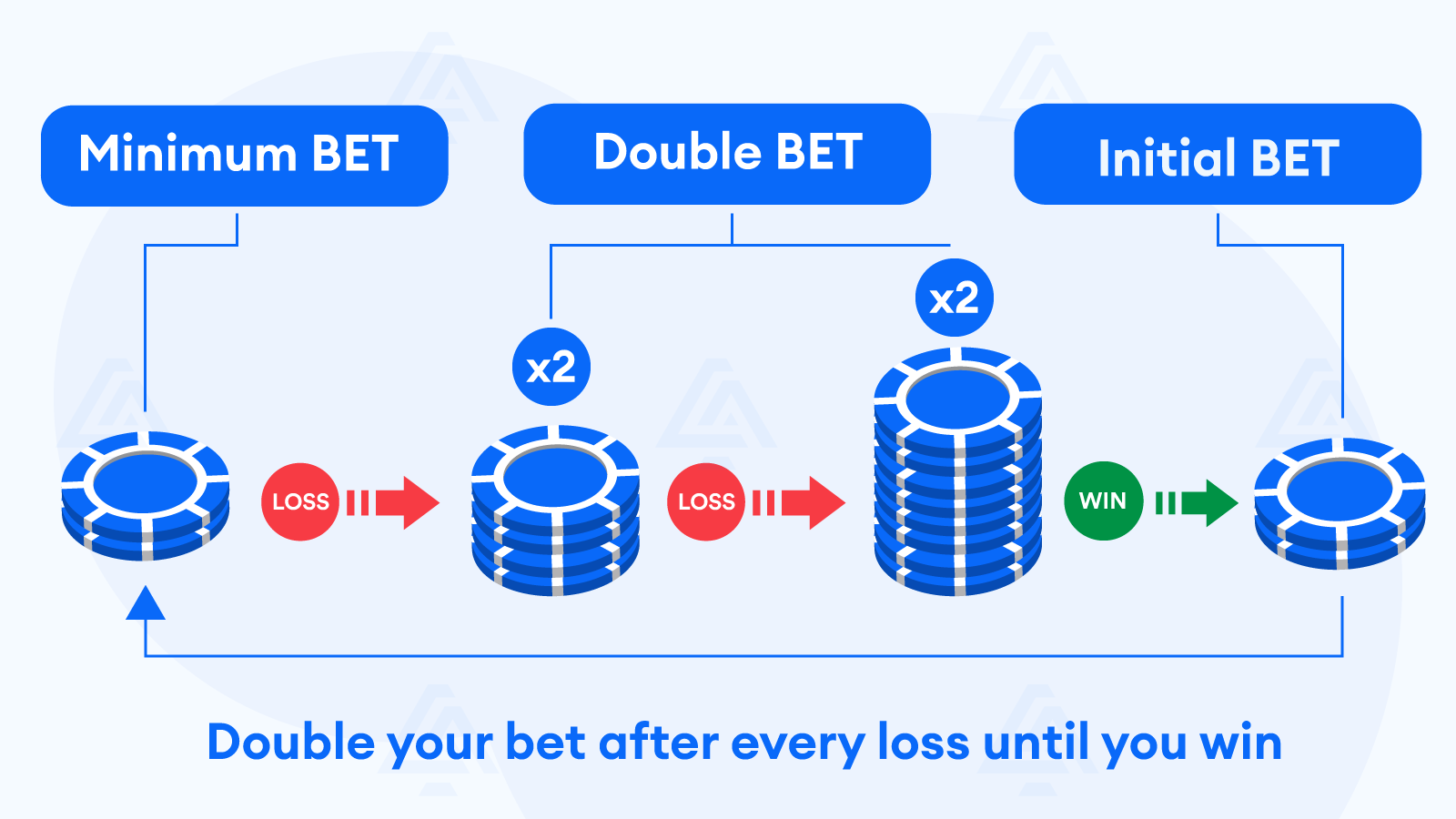
Martingale Betting System
Example
- Bet $10 and lose.
- Bet $20 and lose.
- Bet $40 and lose.
- Bet $80 and win.
- Your total losses are $10 + $20 + $40 = $70, but your win is $80, resulting in a net profit of $10.
Pros
- Simplicity: The Martingale system is easy to understand and implement, making it accessible for beginners.
- Guaranteed Profit (In Theory): If you have an unlimited bankroll and no betting limits, a win will always recover all previous losses plus a profit equal to the initial bet.
Cons
- High Risk: The Martingale system requires a substantial bankroll to withstand extended losing streaks. The exponential growth of bet sizes can quickly become unmanageable.
- Casino Limits: Many casinos have maximum bet limits, which can prevent you from doubling your bets indefinitely and hinder the system’s effectiveness.
- Psychological Pressure: The stress of continually increasing bets during a losing streak can be overwhelming, leading to poor decision-making.
Effectiveness in Crash Games
The Martingale system can be both enticing and perilous when applied to crash games such as Lucky Crumbling Game Online. Here’s a detailed look at its effectiveness:
- Short-Term Gains: In the short term, the Martingale system can lead to quick recoveries and small profits, especially if losing streaks are brief.
- Volatility Management: Crash games are inherently volatile, and the Martingale system’s doubling mechanism can quickly escalate bet sizes, amplifying both potential gains and losses, as often seen in the Zeppelin crash game, where strategic bet management is crucial..
- Risk of Large Losses: Due to the unpredictable nature of crash games, long losing streaks are possible, just like in JetX 3, where volatility can lead to significant losses if not managed carefully.. This can rapidly deplete your bankroll, especially if you hit the casino’s maximum bet limit.
The Paroli System
The Paroli system is a popular positive progression betting strategy that focuses on maximizing profits during winning streaks while minimizing losses during losing periods. Unlike negative progression systems, where you increase your bet after a loss, the Paroli system involves increasing your bet after a win. The primary goal is to capitalize on consecutive wins while maintaining a controlled and disciplined approach to betting.
How It Works
- Start with a Base Bet: Begin with a fixed initial bet amount. For example, let’s say you start with $10.
- Double After Win: If you win the initial bet, double your next bet to $20.
- Repeat the Process: Continue doubling your bet after each win (e.g., $10, $20, $40) until you either reach a predetermined number of wins or decide to reset.
- Reset After a Loss: If you lose at any point, revert back to the initial base bet of $10 and start the process over.
- Set a Winning Limit: Typically, players set a limit of three consecutive wins before resetting to the base bet, to lock in profits and minimize risk.
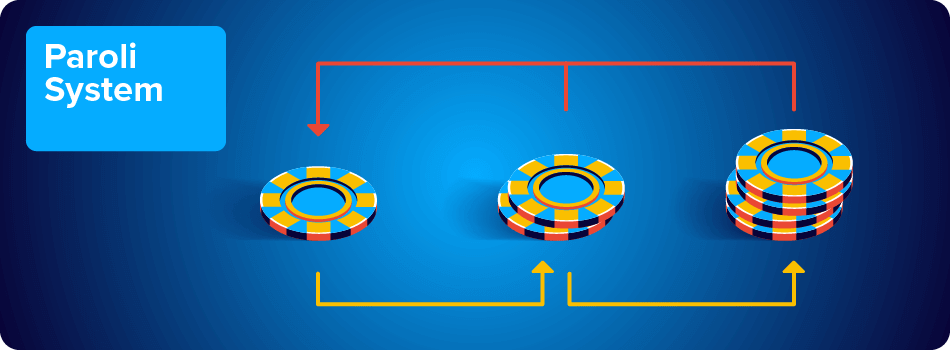
Paroli Betting System
Example
- Bet $10 and win.
- Bet $20 and win.
- Bet $40 and win.
- After three consecutive wins, reset to the initial bet of $10.
Pros
- Controlled Risk: The Paroli system mitigates risk by using winnings to place larger bets, protecting your initial bankroll.
- Psychological Comfort: Winning streaks are psychologically rewarding, and the Paroli system leverages this by encouraging players to bet more only when they are already ahead.
- Simplified Management: It is straightforward to implement and doesn’t require a large bankroll compared to negative progression systems.
Cons
- Limited Winning Streaks: The system relies on the occurrence of winning streaks, which may not happen frequently, limiting the potential for large gains.
- Inconsistent Profits: While it minimizes losses, the system might not yield significant profits if winning streaks are short or infrequent.
- Betting Discipline: Requires strict adherence to resetting after losses and not chasing losses, which can be challenging for some players.
Effectiveness in Crash Games
The Paroli system can be particularly effective in Rocket crash games due to its emphasis on leveraging winning streaks. Here’s a detailed look at its effectiveness:
- Short-Term Profits: In the volatile environment of crash games, the Paroli system can quickly build profits during short winning streaks, making it an attractive option for players looking for immediate gains, similar to strategies often used in Thunder Crash game sessions..
- Risk Management: By doubling bets only after wins, players protect their initial bankroll and reduce the risk of significant losses during losing streaks.
- Psychological Edge: The system’s reliance on winning streaks aligns well with the adrenaline-pumping nature of crash games, providing a psychological boost when players are winning.
The Fibonacci System
The Fibonacci system is a negative progression betting strategy based on the famous Fibonacci sequence. The sequence, which is the sum of the two preceding numbers (1, 1, 2, 3, 5, 8, 13, etc.), provides a structured approach to increasing bets after losses. The system aims to recover losses over a series of bets, with the intention of eventually achieving a profit when a win occurs.
How It Works
- Start with a Base Bet: Begin with a fixed initial bet amount. For example, let’s say you start with $10.
- Follow the Sequence After Losses: If you lose the initial bet, increase your next bet according to the Fibonacci sequence. For instance, if you lose $10, your next bet would also be $10 (1st number in the sequence), followed by $20 (2nd number in the sequence), $30 (3rd number in the sequence), and so on.
- Move Back Two Steps After a Win: After a win, move back two steps in the sequence to determine your next bet. If you are at the 5th step ($50 bet) and win, your next bet should be the 3rd step amount ($20).
- Repeat the Process: Continue following the sequence after each loss and move back two steps after each win until you recover your losses and secure a profit.
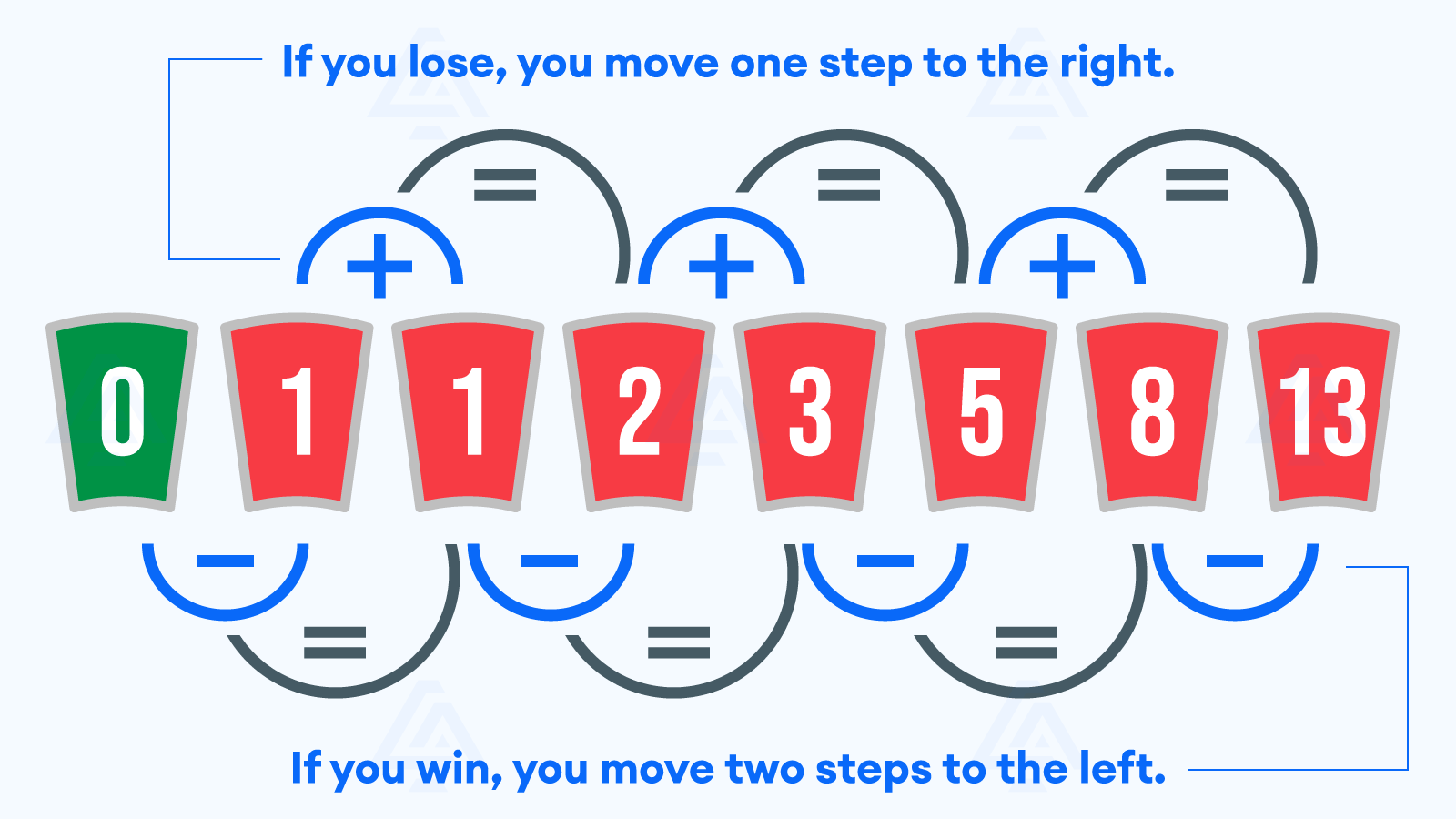
Fibonacci Sequence in Gambling
Example
- Bet $10 and lose.
- Bet $10 and lose.
- Bet $20 and lose.
- Bet $30 and win.
- After a win, move back two steps: your next bet is $10.
Pros
- Gradual Bet Increase: The Fibonacci system increases bets more gradually than other negative progression systems like the Martingale, which helps manage risk.
- Structured Approach: The predefined sequence provides a clear and systematic method for adjusting bet sizes.
- Loss Recovery: The system is designed to recover losses over a series of bets, with the goal of achieving a profit when a win occurs.
Cons
- Complexity: The Fibonacci sequence can be more complicated to track and implement compared to simpler systems.
- Bankroll Requirement: While less aggressive than the Martingale, the system still requires a sizable bankroll to sustain extended losing streaks.
- Potential for Large Losses: Prolonged losing streaks can lead to substantial bets, increasing the risk of significant losses.
Effectiveness in Crash Games
The Fibonacci system can be effective in crash games due to its structured approach and gradual bet increases, similar to the strategic moves required to navigate the Dragon Tower pattern, where careful planning and execution can lead to better outcomes.. Here’s a detailed look at its effectiveness:
- Risk Management: The Fibonacci system’s gradual bet increase helps manage risk better than more aggressive systems, making it suitable for the volatile nature of crash games, similar to strategies used in the Rocket game money, where controlling risk is essential to maximizing potential gains..
- Loss Recovery: By following the sequence, players aim to recover losses over several rounds, aligning well with the unpredictable outcomes of crash games.
- Strategic Flexibility: The system’s structured approach provides a clear framework for bet adjustments, helping players maintain discipline and control.
The D’Alembert System
The D’Alembert system is a popular negative progression betting strategy that offers a less aggressive approach compared to systems like Martingale. Named after the French mathematician Jean le Rond d’Alembert, this system is based on the principle of balancing wins and losses over time. The D’Alembert system involves incrementally increasing your bets after losses and decreasing them after wins, aiming to gradually recover losses without the need for large, rapid increases in bet size.
How It Works
- Start with a Base Bet: Begin with a fixed initial bet amount. For example, let’s say you start with $10.
- Increase After Loss: If you lose the initial bet, increase your next bet by one unit (e.g., from $10 to $11).
- Decrease After Win: If you win a bet, decrease your next bet by one unit (e.g., from $11 to $10).
- Repeat the Process: Continue increasing your bet by one unit after each loss and decreasing by one unit after each win until you achieve your desired profit or decide to stop.
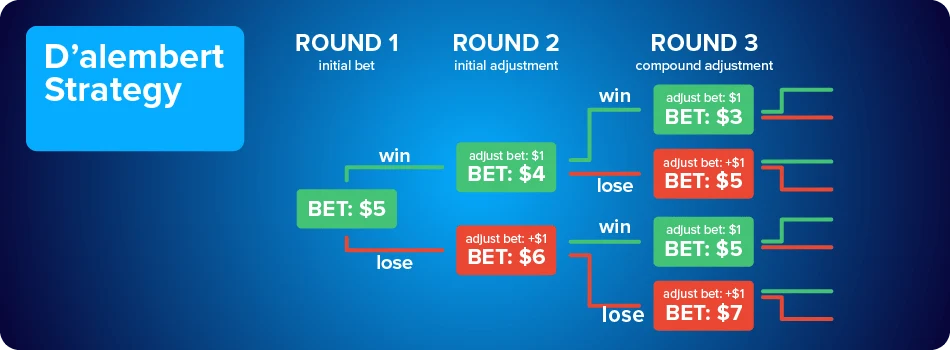
Dalembert System
Example
- Bet $10 and lose.
- Bet $11 and lose.
- Bet $12 and win.
- Bet $11 and win.
- After a series of wins and losses, your bets gradually adjust, aiming to balance your overall gains and losses.
Pros
- Less Aggressive: The D’Alembert system increases bet sizes more gradually than other negative progression systems, reducing the risk of large, rapid losses.
- Manageable: The system is straightforward and easy to implement, making it suitable for beginners.
- Balancing: Designed to balance wins and losses over time, offering a more controlled approach to betting.
Cons
- Slow Progress: The gradual nature of the system means that it can take a long time to recover losses and achieve significant profits.
- Potential for Moderate Losses: While less aggressive, the system can still lead to moderate losses during prolonged losing streaks.
- Discipline Required: Success with the D’Alembert system requires strict adherence to the betting pattern and discipline to avoid deviating from the strategy.
Effectiveness in Crash Games
The D’Alembert system can be quite effective in crash games due to its balanced and less aggressive approach. Here’s a detailed look at its effectiveness:
- Risk Management: The incremental adjustments to bet sizes help manage risk better than more aggressive systems, making it well-suited for the volatile nature of crash games, similar to strategies used in the Fruit Tower game, where careful planning can lead to more consistent wins..
- Consistency: The system’s focus on balancing wins and losses over time aligns well with the unpredictable outcomes of crash games, providing a steady approach to betting, much like the strategy required in the Dino game, where managing risk and maintaining balance are key to success..
- Psychological Comfort: The gradual increases and decreases in bet sizes can provide psychological comfort, helping players maintain discipline and avoid the stress associated with larger, rapid bet increases.
The Labouchere System
The Labouchere system, also known as the cancellation system or split martingale, is a negative progression betting strategy that allows players to customize their betting sequence to target specific profit goals. Named after Henry Labouchere, this system is designed to recover losses over a series of bets by following a predetermined sequence. The Labouchere system is more complex than other negative progression systems but offers flexibility and a structured approach to achieving your desired profit.
How It Works
- Set a Sequence: Start by writing down a sequence of numbers that add up to your desired profit. For example, if you want to make a profit of $10, you might use the sequence 1-2-3-4 (which adds up to 10).
- Place Your Bet: Your bet amount is the sum of the first and last numbers in the sequence. In this example, your first bet would be $5 (1 + 4).
- Adjust the Sequence After a Win: If you win, remove the first and last numbers from the sequence. For the next bet, use the new first and last numbers. If your sequence was 1-2-3-4 and you won, the new sequence would be 2-3, and your next bet would be $5 (2 + 3).
- Adjust the Sequence After a Loss: If you lose, add the amount of the lost bet to the end of the sequence. If you lost your first bet of $5, your new sequence would be 1-2-3-4-5, and your next bet would be $6 (1 + 5).
- Repeat the Process: Continue this process until all numbers are canceled out or until you decide to stop.
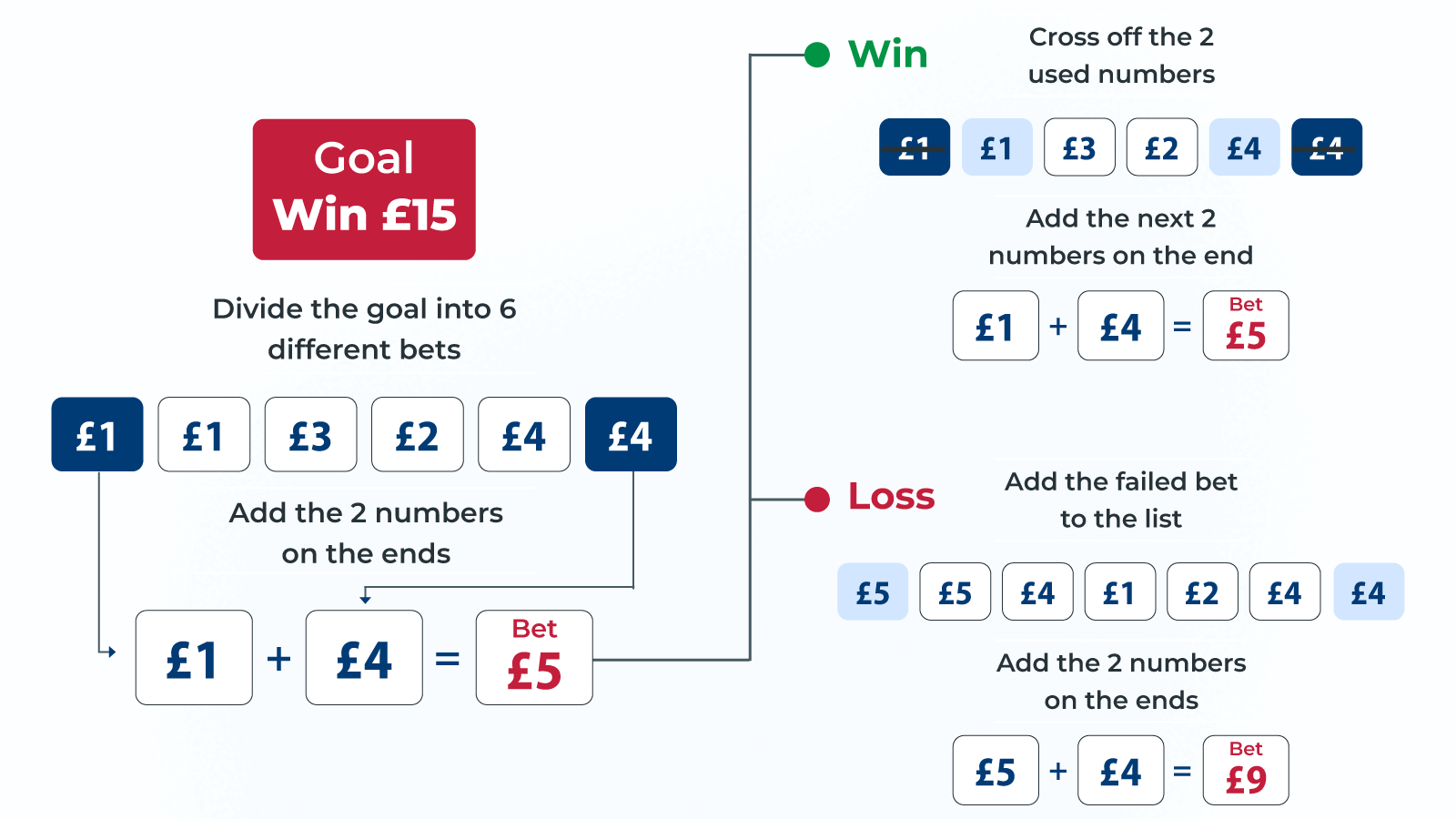
Labouchere System
Example
- Sequence: 1-2-3-4
- Bet $5 (1 + 4) and lose.
- New sequence: 1-2-3-4-5
- Bet $6 (1 + 5) and win.
- New sequence: 2-3-4
- Bet $6 (2 + 4) and win.
- New sequence: 3
- Bet $3 and win.
- Sequence completed; you achieved your profit goal.
Pros
- Flexible and Customizable: Allows players to set their own profit targets and adjust the sequence to fit their goals.
- Structured Approach: Provides a clear and systematic method for adjusting bets and tracking progress.
- Potential for Quick Recovery: Can quickly recover losses if you experience alternating wins and losses.
Cons
- Complexity: The system can be challenging to track and manage, especially for beginners.
- Requires Discipline: Success with the Labouchere system requires strict adherence to the sequence and betting pattern.
- Bankroll Requirement: Like other negative progression systems, it requires a substantial bankroll to sustain extended losing streaks.
Effectiveness in Crash Games
The Labouchere system can be effective in crash games due to its structured and flexible nature. Here’s a detailed look at its effectiveness:
- Customizable Strategy: The ability to set your own profit goals and sequence allows for a tailored approach that can adapt to the dynamic nature of crash games, similar to the gameplay in Crazy Professor game, where strategic choices enhance the overall experience and potential for success..
- Risk Management: While it involves negative progression, the system’s structured adjustments can help manage risk and avoid overly aggressive betting.
- Psychological Comfort: The clear sequence and systematic method can provide psychological comfort, helping players maintain discipline and focus.
Oscar’s Grind
Oscar’s Grind, also known as the “positive progression” system, is a betting strategy designed to achieve steady, incremental profits while minimizing risk. This system is based on a series of small, controlled bets, increasing your wager after a win and keeping it the same after a loss. The goal is to gradually build up winnings in a balanced and disciplined manner, making it particularly suitable for players who prefer a low-risk approach.
How It Works
- Start with a Base Bet: Begin with a fixed initial bet amount. For example, let’s say you start with $10.
- Increase After a Win: If you win the bet, increase your next bet by one unit (e.g., from $10 to $20).
- Keep the Bet Same After a Loss: If you lose the bet, maintain your next bet at the same amount (e.g., keep betting $10).
- Repeat the Process: Continue increasing your bet by one unit after each win and keeping it the same after each loss until you reach your desired profit or decide to stop.
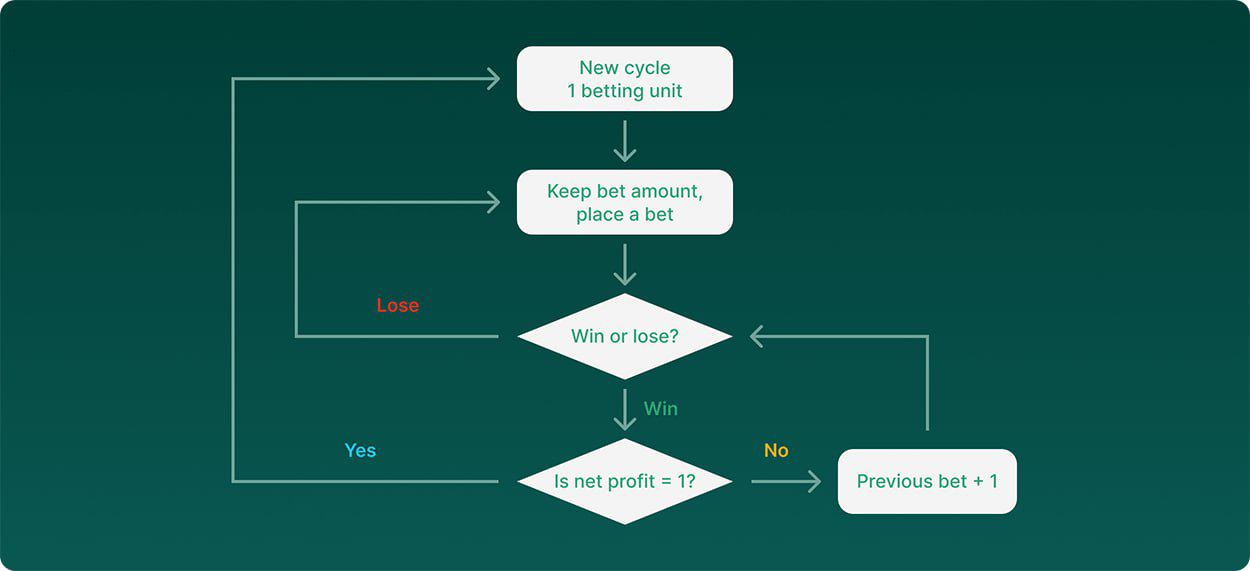
Oscar’s Grind Betting Strategy
Example
- Bet $10 and win.
- Bet $20 and win.
- Bet $30 and lose.
- Bet $30 and win.
- Bet $40 and lose.
- Bet $40 and win.
Pros
- Low Risk: By only increasing your bets after wins and keeping them the same after losses, the system minimizes risk and helps protect your bankroll.
- Steady Gains: Designed to achieve a series of small, consistent profits, making it ideal for players who prefer a gradual increase in their winnings.
- Psychological Comfort: The incremental nature of the system reduces the psychological pressure associated with large, rapid bet increases.
Cons
- Slow Progress: The system focuses on steady, incremental gains, which means it can take longer to achieve significant profits compared to more aggressive strategies.
- Discipline Required: Success with Oscar’s Grind requires strict adherence to the betting pattern and discipline to avoid chasing losses.
- Potential for Stagnation: During extended periods of alternating wins and losses, the system may result in minimal overall progress.
Effectiveness in Crash Games
Oscar’s Grind can be particularly effective in crash games due to its balanced and low-risk approach. Here’s a detailed look at its effectiveness:
- Risk Management: The system’s conservative nature helps manage risk better than more aggressive systems, making it suitable for the volatile environment of crash games.
- Consistency: By focusing on small, steady gains, players can enjoy a more consistent betting experience, which aligns well with the unpredictable outcomes of crash games.
- Psychological Comfort: The gradual bet increases and stable approach can provide psychological comfort, helping players maintain discipline and avoid impulsive decisions.
The 1-3-2-6 System
The 1-3-2-6 system is a positive progression betting strategy designed to maximize profits during short winning streaks while limiting potential losses. This system follows a four-step sequence of increasing bets and is particularly appealing for its simplicity and structured approach. The goal is to capitalize on winning streaks without risking significant losses, making it a popular choice for many gamblers.
How It Works
- Start with a Base Bet: Begin with a fixed initial bet amount, referred to as “1 unit”. For example, if you start with $10, this is your “1 unit”.
- Follow the Sequence: The system involves betting in the following sequence: 1 unit, 3 units, 2 units, 6 units.
- First Bet: Bet 1 unit (e.g., $10). If you win, move to the next step.
- Second Bet: Bet 3 units (e.g., $30). If you win, move to the next step.
- Third Bet: Bet 2 units (e.g., $20). If you win, move to the final step.
- Fourth Bet: Bet 6 units (e.g., $60). If you win, the sequence is complete, and you start over.
- Reset After a Loss: If you lose at any point in the sequence, reset back to 1 unit and start the sequence over.
- Repeat the Process: Continue following the sequence until you either achieve your desired profit or decide to stop.

1-3-2-6 Betting System
Example
- Bet $10 and win.
- Bet $30 and win.
- Bet $20 and win.
- Bet $60 and win.
- After completing the sequence, reset to the initial bet of $10.
Pros
- Limits Losses: By resetting the sequence after a loss, the system limits potential losses and protects your bankroll.
- Simple to Remember: The straightforward sequence (1, 3, 2, 6) is easy to remember and follow.
- Maximizes Short Winning Streaks: The system is designed to capitalize on short winning streaks, allowing you to maximize profits during favorable runs.
Cons
- Relies on Winning Streaks: The system’s effectiveness depends on hitting short winning streaks, which may not occur frequently.
- Limited Profit Potential: While it limits losses, the system also limits potential profits compared to more aggressive strategies.
- Discipline Required: Success with the 1-3-2-6 system requires strict adherence to the sequence and the ability to reset after losses without chasing losses.
Effectiveness in Crash Games
The 1-3-2-6 system can be effective in crash games due to its structured and disciplined approach. Here’s a detailed look at its effectiveness:
- Risk Management: The system’s conservative nature helps manage risk better than more aggressive systems, making it suitable for the volatile environment of crash games.
- Consistency: By focusing on short, controlled sequences of bets, players can enjoy a more consistent betting experience, aligning well with the unpredictable outcomes of crash games.
- Psychological Comfort: The clear and simple sequence can provide psychological comfort, helping players maintain discipline and avoid impulsive decisions.
Other Betting Systems
Red Snake
The Red Snake betting system, originally for roulette, can be adapted to crash games to manage risk and aim for consistent profits. Start with a fixed initial bet, such as $10, and choose specific cash-out points like 1.5x, 2x, and 3x in a repeating pattern. Increase your bet slightly after each win and reset to the initial amount after a loss, similar to the Paroli system. This structured approach helps manage bets and aims for steady gains. While the system offers a clear, adaptable strategy that can reduce impulsive decisions, it can be complex to adapt from roulette and requires strict discipline. Following the pattern and maintaining consistency can enhance the gaming experience and lead to more consistent outcomes.
Kelly Criterion
The Kelly Criterion is a mathematical formula used to determine the optimal size of a series of bets to maximize long-term growth. In crash games, it helps balance risk and reward by calculating the ideal bet size based on the probability of winning and the potential payout. The formula is: Bet Size = (BP – Q) / B, where B is the decimal odds minus 1, P is the probability of winning, and Q is the probability of losing. Using the Kelly Criterion, players can avoid over-betting and under-betting by adjusting their wagers according to their edge in the game. This method aims to maximize profits while minimizing the risk of ruin, making it a strategic approach for serious players. However, it requires accurate estimation of win probabilities and discipline to follow the calculated bet sizes, which can be challenging in the unpredictable environment of crash games, much like in Speed and Cash game, where precise decision-making and strategy are essential for success.. By adhering to the Kelly Criterion, players can enhance their long-term success and make more informed betting decisions.
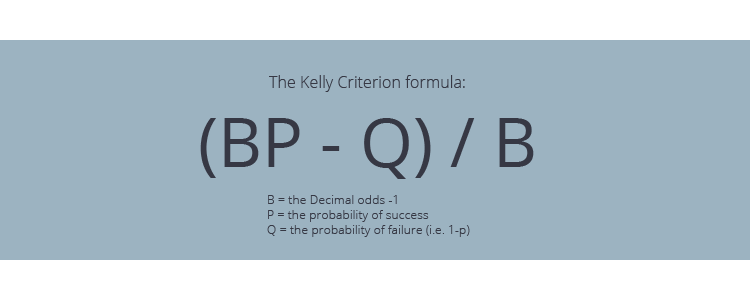
Kelly Criterion Formula
Can You Apply these Systems to All Online Casino Games?
No, not all betting strategies work for all casino games. Strategies that involve progressively increasing bets can be effective in games with even-money bets but carry significant risk during losing streaks. Approaches that leverage winning streaks are suitable for games like Aviator with even-money bets and help minimize risk while maximizing short-term gains. Systems designed to balance wins and losses over time require discipline and are better suited for games where you can bet consistently. Some strategies optimize bet sizes based on win probabilities and potential payouts, making them versatile but requiring accurate estimates and careful management. The success of each strategy depends on the specific rules and mechanics of the game, as well as the player’s ability to manage their bankroll and maintain discipline.
Is there a System that Guarantee Win?
Casino games are designed with a house edge, meaning the odds are always slightly in favor of the casino. While some betting systems can help manage risk and potentially increase the chances of short-term success, none can eliminate the house edge or ensure consistent, guaranteed wins. The outcomes of casino games are ultimately based on chance and probability, making it impossible for any system to guarantee a win in the long run. Effective bankroll management and disciplined play can improve your overall experience, but there is always a risk of losing when gambling.
So What are the Best Betting Systems for Crash Gambling
For crash games, the Paroli system and the Kelly Criterion are better suited due to their strategic advantages.
- Paroli System: This positive progression system is effective because it capitalizes on winning streaks while minimizing risk. By doubling bets after each win and resetting after a loss, players can maximize profits during favorable streaks without risking large portions of their bankroll.
- Kelly Criterion: This mathematical formula optimizes bet sizes based on win probabilities and potential payouts, making it versatile and strategic. It helps players avoid over-betting and under-betting, balancing risk and reward to maximize long-term growth while minimizing the risk of ruin.
Both systems offer structured approaches that align well with the volatile nature of crash games, providing better risk management and potential for consistent profits.
FAQ
Why do some players swear by the Martingale system despite its risks?
Some players find the Martingale system appealing because of its simplicity and the potential to recover losses quickly. However, it requires a substantial bankroll and carries the risk of significant losses during prolonged losing streaks, which can wipe out funds quickly.
Is the Kelly Criterion too complicated for the average player?
The Kelly Criterion can seem complex because it involves calculating optimal bet sizes based on probabilities and potential payouts. However, many find it worthwhile as it helps balance risk and reward, optimizing long-term growth and minimizing the risk of ruin. With practice, the calculations become easier to manage.
Why do some experts recommend the Paroli system for crash games?
The Paroli system is recommended because it capitalizes on winning streaks and minimizes risk by only increasing bets after a win. This positive progression strategy is less aggressive than others and helps players maximize profits during favorable runs without risking large portions of their bankroll.
Are betting systems just a way to make players feel more in control?
Betting systems can provide a sense of structure and control, which might help players make more disciplined decisions. However, it's crucial to remember that no system can change the fundamental odds of the game. They can improve the gaming experience and potentially enhance short-term success but do not alter the inherent house edge.
Are there any betting systems that professionals avoid?
Many professionals avoid highly aggressive systems like the Martingale due to the high risk of substantial losses. They tend to prefer more balanced and mathematically grounded approaches, such as the Kelly Criterion, which optimize bet sizes and manage risk more effectively over the long term.




